Assessing Carbon Footprint of Textile Spinning Process in Bangladesh
Fahmida E Karim1*, Md. Redwanul Islam2, Sk Nazmus Saaqib3, Tareq Iqbal4 and Kazi Rezwan Hossain2
1 Lecturer, Department of Textile Engineering, BGMEA University of Fashion and Technology (BUFT), Bangladesh
2 Lecturer, Department of Textile Engineering, Ahsanullah University of Science and Technology (AUST), Bangladesh
3 Assistant Professor (Fashion & Design), Pabna Textile Engineering College, Pabna, Bangladesh
4 Lecturer, Department of Textile Engineering and Management, BGMEA University of Fashion and Technology (BUFT), Bangladesh
Submission: March 18, 2022; Published: April 07, 2022
*Corresponding author: Fahmida E Karim, Lecturer, Department of Textile Engineering, BGMEA University of Fashion and Technology (BUFT), Bangladesh
How to cite this article: Fahmida E K, Md Redwanul I, Sk Nazmus S, Tareq I, Kazi R H. Assessing Carbon Footprint of Textile Spinning Process in Bangladesh. The Case of Candanchú (Spain). Int J Environ Sci Nat Res. 2022; 30(2): 556281. DOI: 10.19080/IJESNR.2022.30.556281
Abstract
Carbon footprint is described as the quantity of greenhouse gases generated at some stage in the entire lifetime or within a precise boundary of a product. This study measured the average carbon footprint of spinning process the use of CCalC2 software [1]. Global population increase and rising living requirements are increasing garb consumption. Consequently, consumption of resources and era of cloth waste are increasing. From this study it is helpful to gather knowledge about carbon footprint of textile spinning process in Bangladesh. Already the developed countries are calculation this carbon footprint and take necessary steps to control the emission of carbon dioxide gas for making a sustainable world. Spinning process is the beginning process in textile sector and this sector emits huge amount of CO2. So it is necessary to control emission of CO2 gas from this beginning process.
Keywords: Carbon footprint; CCalC2 software; Spinning; Carbon dioxide
Introduction
“Global warming” and “carbon footprint” are a buzz phrase now. Its significance and the consequential long time period devastating effects of “Climate Change” on the environment, habitat and even the existence of our mother Earth are broadly discussed. This warming of atmospheric temperature is attributed to the emission of Green House Gases (GHG)–Carbon Dioxide, Methane, Nitrous Oxide and Fluorocarbons are the main contributors [2]. The Green House Gas emission is precipitated by the manufacturing and consumption of fuels, manufactured goods, materials, wood, roads, and services. For simplicity of reporting, it is often expressed in phrases of the amount of carbon dioxide, or its equivalent of other GHGs, emitted. Just as strolling on the sand leaves a footprint, burning gas leaves carbon dioxide in the air, which is called a “Carbon Footprint”. Thus, the carbon footprint basically relates to the quantity of carbon launched into the air primarily based on the gas consumption. The circular economy is governed by 3Rs, namely Reduce, Reuse, and Recycle, which are the foremost strategies for eco-friendly processing of textile/apparel products. Both round financial system and 3Rs thinking are interchangeable in waste administration process. In 3Rs concept, the phrase Reduction has plenty wider scope and emphasis in waste discount at more than a few sequences of manufacturing manner and distinctive ranges of consumption [3].
According to estimates, textiles and apparel usually account for round 4 per cent of the secondary carbon feet print of a person in the developed world. Thanks to a wide variety of factors which include the growing consciousness of environmental concerns, and perhaps more importantly, the benefits the textiles enterprise hopes to reap from decreasing its carbon footprint, the enterprise has taken several initiatives in the direction of lowering its carbon footprint. Spurred through these factors, the fabric industry and gamers throughout the fee chain have adopted a number strategy for lowering the carbon footprint. Besides the textile industry's swap to extra strength environment friendly processes, agencies throughout the provide chain have additionally pitched in with progressive products with smaller carbon footprints.
DuPont, the US based chemical compounds major, that revolutionized the fiber enterprise with the introduction of man-made fibers like nylon, rayon and spandex now provides Sorona, a polymer which is made with agricultural feedstock’s alternatively of petrochemicals. Sorona has excessive renewable ingredients content material - 37 per cent by way of weight. Fabrics made with Sorona supply a 30-per cent carbon dioxide discount while the Sorona manufacturing technique reduces greenhouse fuel emissions by 63 per cent, in contrast to conventional nylon made from petroleum [4].
Materials and Methods
Materials
i. Cotton fiber: Annual cotton production exceeds 25 million metric tons and money owed for more than 40 percentage of the cloth fiber ate up worldwide. A key textile fiber for over 5000 years, this complex carbohydrate is additionally one of the main crops to gain from genetic engineering [5].
ii. Blow room: The blow room is essential stage of spinning for producing easy passage of raw material, required for subsequent process. The impact of beater speed, grid bar setting is used for opening, cleaning and individualizations of fibers [6].
iii. Carding: Draft processing and carding processing in carding method were researched. The relationship between the two processing was discussed. Carding technology aspects have been introduced, the significance of carding aspects used to be analyzed in details. Through comparing exceptional carding processing, effects of processing on product best had been analyzed, such as gauge between take-in and feed plate, feed plate carding length, cylinder and take-in linear pace ratio, gauges between cylinder and movable flat. It is viewed that the core of carding processing is dealing the relationship amongst carding degree, carding strength and switch correctly [7].
iv. Draw frame: Fiber parallelization and blending have done here. Considering the significance of high draw frame delivery speed and as a result the sliver preparations to gain the objective, it has been observed that the draw body transport velocity and its preparatory, viz. card draft and coiler diameter, can have strong influence on the fiber orientation parameters of the sliver [8].
v. Simplex: The main characteristic of simplex desktop is the attenuation of drawn sliver and inserts small quantity of twist to supply required electricity of roving. Finally, the twisted roving is wound on to bobbin. Simplex machine is used to the carded and combed yarn process however for the rotor spinning system this technique can be eliminated [9].
vi. Ring frame: The productiveness and affectivity of ring frame in general relies upon on many factors like traveller, ring diameter, spindle pace etc. When high velocity spindle is used, it generates fly dirt and motives fiber breakage. Hence there is a want of selecting best velocity of spindle, the place one can get correct manufacturing system as nicely as product quality [10].
vii. CCalC2 software: CCalC2 software program developed by way of the University of Manchester, which was once selected due to its extensive database and its elementary accessibility. Two simulation runs of the LCA with bioethanol as a general before addressing the RD were used to make sure the consistency and coherence of consequences with facts suggested in the literature [11].
Method
CCaLC2 for Windows is the second generation of the CCaLC tool that was originally
developed for Microsoft Excel. Departing away from Excel, CCaLC2 tool has been
developed in C#.NET as a Microsoft Windows stand-alone desktop application, making it
more robust, faster and easier to use. The values of raw materials, production and storages are inputted which were collected from textile industry. Then the CCalC2 software calculates the carbon footprint of the data. The life cycle environmental influences of yoghurt grant to the end person in Turkey were investigated. Turkey is the 2d biggest yoghurt producer in the world; therefore, reducing the environmental footprint of yoghurt production is of utmost importance from cleaner production and sustainability factors of view. The purposeful unit was once chosen as 1 ton of yoghurt, CCaLC2™ used to be used as software, and CML2001 methodology was once used. A cradle-to-grave strategy used to be employed. The manufacturing strategies had been modeled based totally on real existence facts received from a major yoghurt manufacturing enterprise in Turkey [12].
Result and Discussion
The impact on the carbon footprint of biogenic carbon storage or carbon uptake in products can be accounted for in CCaLC2. The impact of this reflects the weighted
average time of storage during a 100-year assessment period. Two carbon storage
cases may be defined:
a) a specific case of biogenic carbon storage following product formation; and
b) a general case of biogenic carbon storage or carbon uptake.
For a specific case where the carbon storage benefit of a product exists between 2 and
25 years after product formation (and no carbon storage benefit exists after that time),the weighting factor applied is as follows:
Weighting factor = (0.76 x t0)/100
where t0 is the number of years the full carbon storage benefit of the product exists
following its formation. For a general case, the weighting factor to be applied to the CO2 storage benefit over the 100-year assessment period is calculated as follows:

where i is each year in which storage occurs and x is the proportion of total storage
remaining in any year i (Figure 1-4).
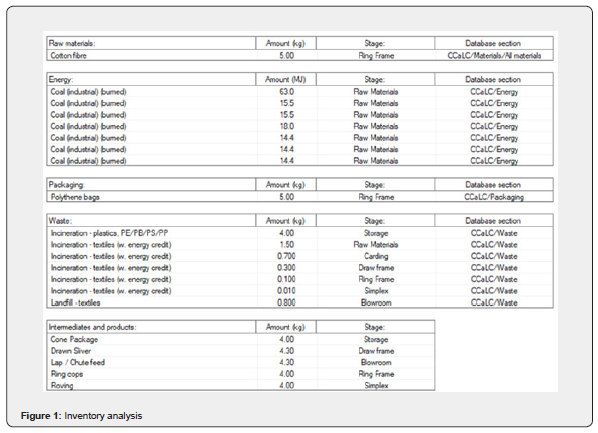

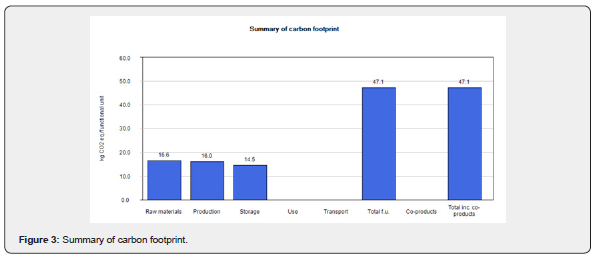
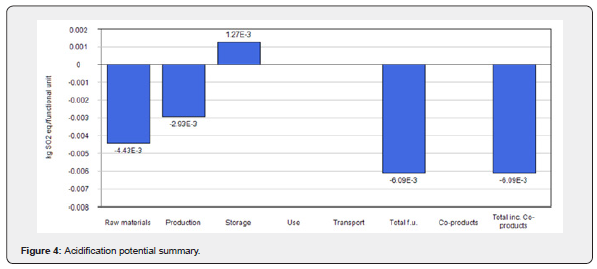

From the Figure 4 it’s shown that the increasing rate of carbon dioxide emission also acidify the environment (Figure 5-8).
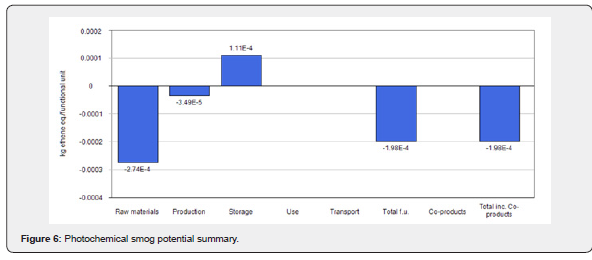
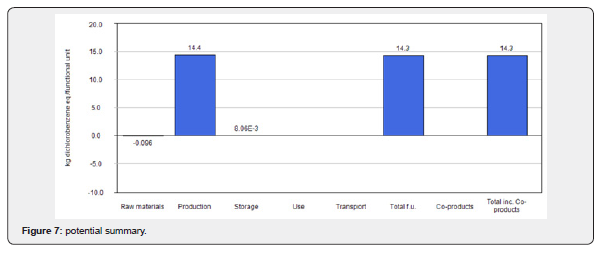
From the above figures it’s clear to us that the carbon dioxide is increasing day by day in our everyday livelihood works.
Conclusion
Global warming represents an important concern on all society levels along with governments, monetary actors, and citizens. The spinning industry is often considered a polluting activity. In this work spinning factories sought to quantify the carbon footprint (CF) of bought clothes and family linen the use of the Life Cycle Assessment to reduce it to meet the constraints of the Paris Agreement by way of 2050.
The priority for decreasing the spinning factories and spinning wastage be to discover material production in nations with (i) low carbon electricity, (ii) to decrease unsold items, and (iii) to problematic eco-design of a product such as the round economy.
It is necessary to behavior lookup related to carbon footprint from settlement activities with the aid of adding the calculation of Carbon dioxide emissions generated from waste Generation in Households. The estimated carbon footprint of this Carbon footprint undertaking is then mapped the use of a Geographic Information System to describe the Distribution of the carbon footprint of an area. The results of this lookup will be expected to be used in Making suitable mitigation selections or policies to reduce carbon emissions.

References
- Amin M, Mahmud M, Anannya FR (2021) Assessment of Carbon Footprint of Various Cotton Knitwear Production Processes in Bangladesh. AATCC Journal of Research 8(6): 47-57.
- Athalye A (2012) Carbon footprint in textile processing. Colourage 59(12): 45-47.
- Manickam P, Duraisamy G (2019) 4-3Rs and circular economy. Circular Economy in Textiles and Apparel, pp. 77-93.
- Domain-b.com: Carbon footprint of textiles.
- Wakelyn PJ (2006) Cotton fiber chemistry and technology. CRC Press, USA.
- Patil UG, Raichurkar PP, Mukherjee S (2012) Effect of cleaning point of uniclean machine in blow room on cleaning efficiency and yarn quality.
- Shimin N (2011) Research of Carding Processing in Carding Process. Cotton Textile Technology 8.
- Ishtiaque SM, Mukhopadhyay A, Kumar A (2009) Impact of carding parameters and draw frame speed on fibre axial distribution in ring-spun yarn. IJFTR 34(3): 231-238.
- Rahman M (2022) Simplex Machine. Spinning Process of Textile Technology.
- Islam MR, Chakrabortty A, Ghosh J, Iqbal T, Hossen MT (2021) Importance of spindle speed in ring frame. International Journal of Engineering & Technology 10(2): 85-88.
- Mortimer ND, Elsayed MA, Horne RE (2004) Energy and greenhouse gas emissions for bioethanol production from wheat grain and sugar beet. Resources Research Unit School of Environment and Development, Sheffield Hallam University, Sheffield.
- Üçtuğ FG, Atluğkoyun Aİ, İnaltekin M (2019) Environmental life cycle assessment of yoghurt supply to consumer in Turkey. Journal of Cleaner Production 215: 1103-1111.






























